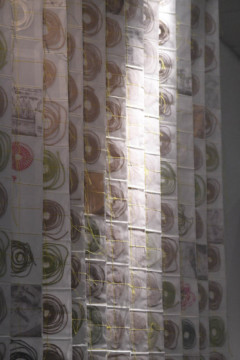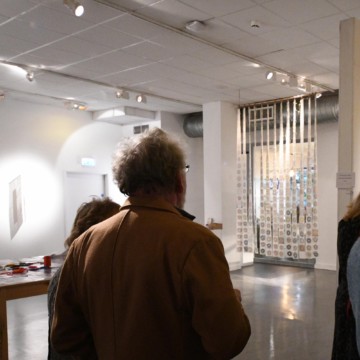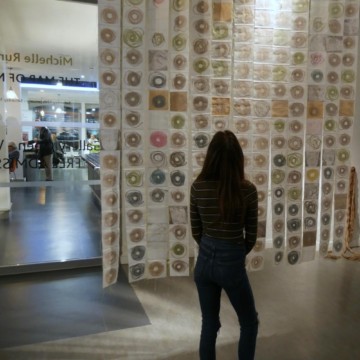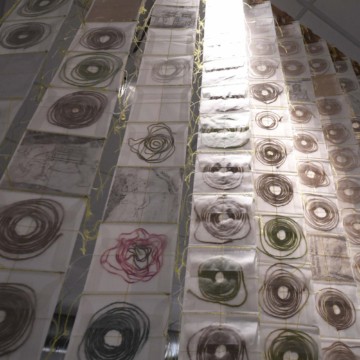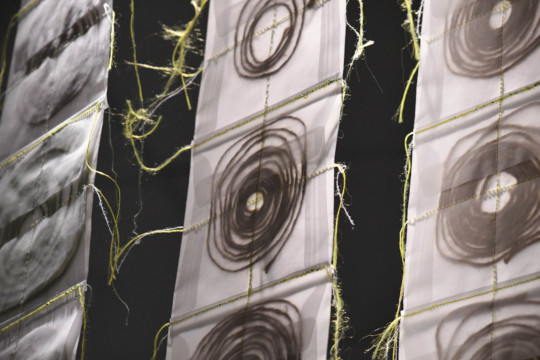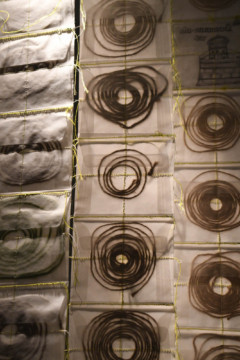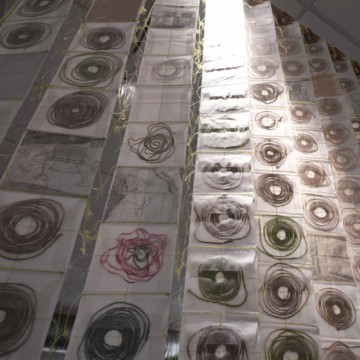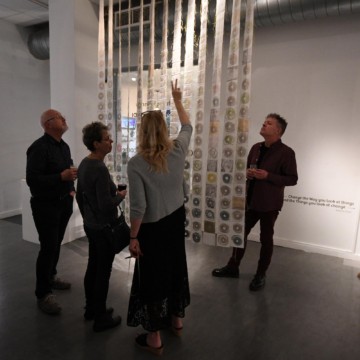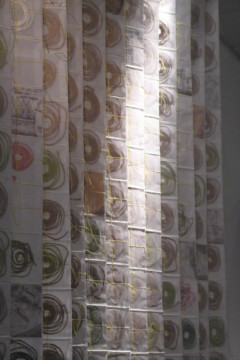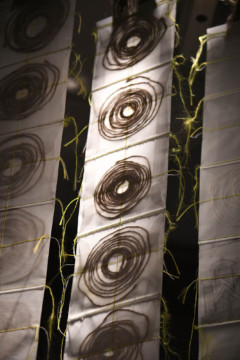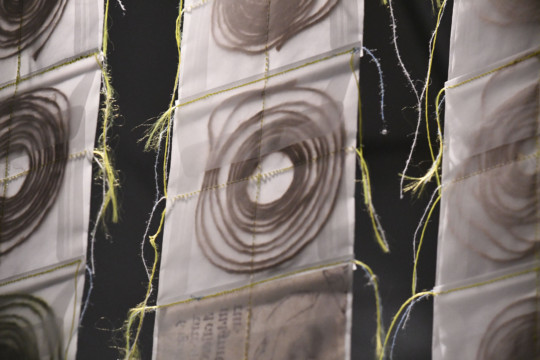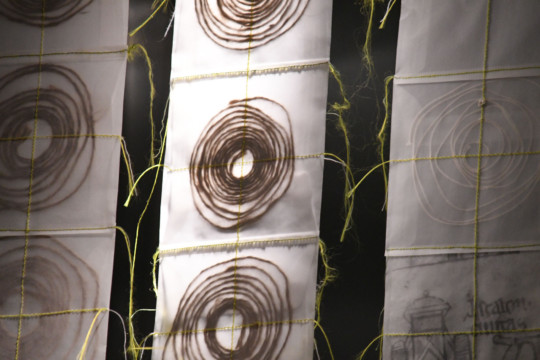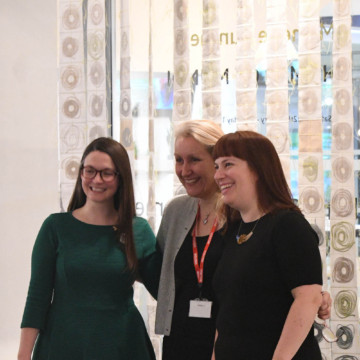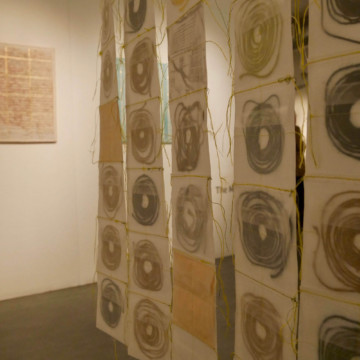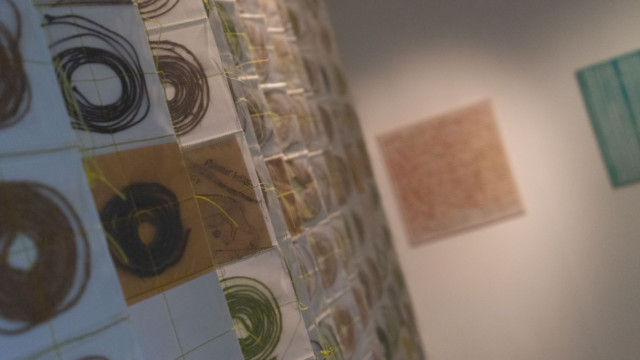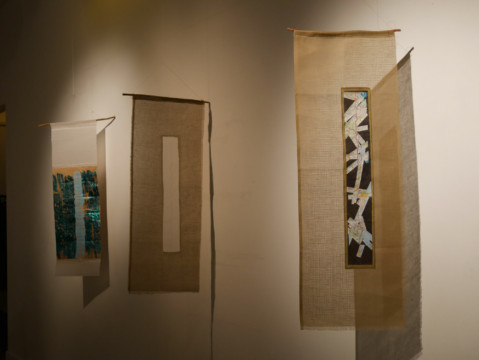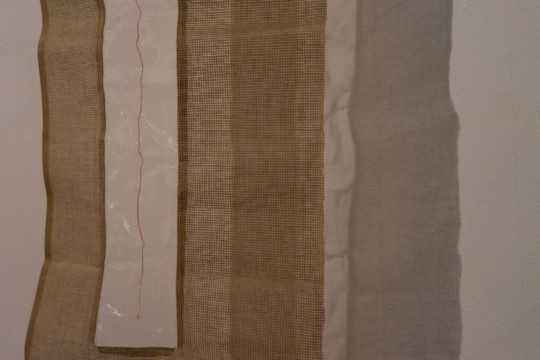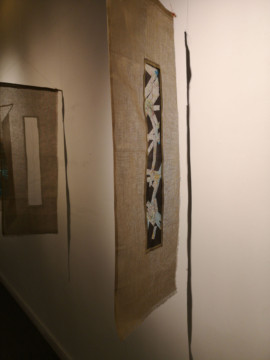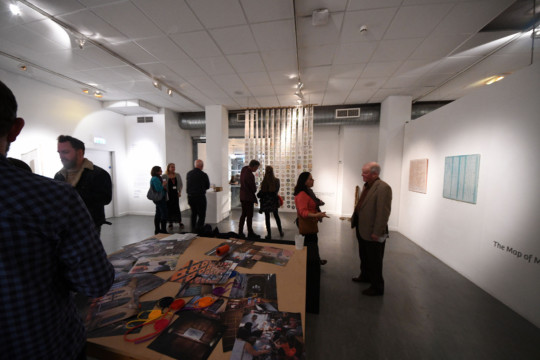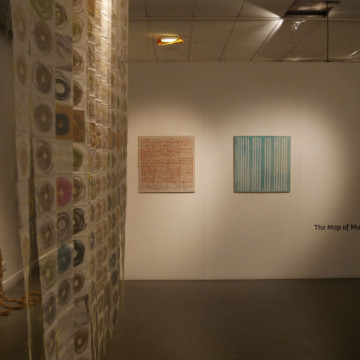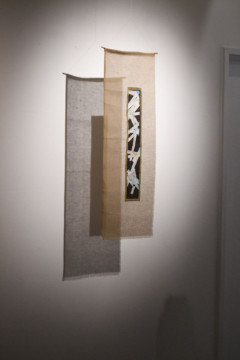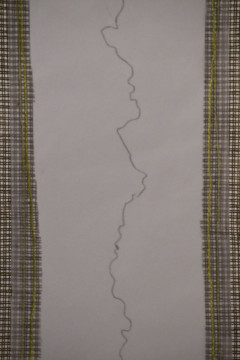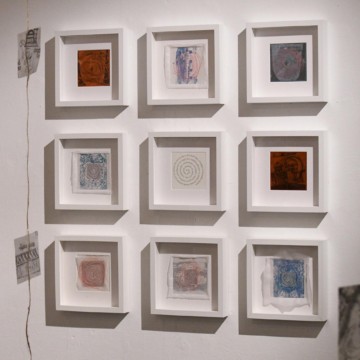The Map of Mundi Exhibition
Late in 2018, I was invited to bring the St Thomas Way touring exhibition away from the Welsh heritage trail and much closer to home – to Lighthouse Poole’s Centre for the Arts. This would be the first time that this work had been shown in a non-religious context; the work had been created originally for specific spaces in Hereford Cathedral and has since been showing in a series of medieval buildings, on an exhibition ‘pilgrimage’ of its own along St Thomas Way.
Each time the ‘Re-Making Maps of the Mind: Medieval and Modern Journeys’ exhibition has been hung in a new location along St Thomas Way, it’s surprised me how well the works in the exhibition have fitted the spaces. Medieval church architecture has a lot to do with this of course – I’ve been hanging the works in familiar arched nooks, beside stained glass windows, in dark corners and on old stone walls – and it has always looked like the work belonged. Hanging works in these spaces has often helped draw attention to lesser-visited parts of the building, encouraging everyone, even if they know their church really well, to look anew. So, the idea of bringing the work into a plain white gallery space without the help of a spectacular medieval church or cathedral meant I had to literally reinvent the whole exhibition – and approach this all in a different way.
With the generous support of a National Lottery Award from Arts Council England, some extra support from Professor Catherine Clarke and the University of Southampton and the backing of Hereford Cathedral, this ultimately became possible and I was able to bring a fresh exhibition experience to my home town.
More than the sum of its parts?
So, for this different space and audience, I decided to shift the focus and include three main elements that are not part of the St Thomas Way Touring Exhibition:
- Have the artist present in the space throughout the exhibition run
- Offer a series of weekly public Workshops throughout the exhibition run, allowing visitors to explore themes in the exhibition themselves and add their own works into the show
- Include the original Mappa Mundi as a key part of the experience
1. Artist at Work?
Well, that was the idea, though making my own work turned out not to be ‘the work’! I imagined that in the 3 days + per week I was present at my work table in the gallery, I would be able to get on with making more work exploring the themes in the exhibition myself. Of course, this would have been entirely possible if it wasn’t for the constant stream of curious visitors who stepped through the door all day long. My ‘work’ became guided-touring, question-asking and storytelling. And indeed luring many visitors to the work table to make a little something themselves or come back for a group workshop, which several of them did:
2. All Join In?
I already knew from the public workshops I’d run for St Thomas Way when we launched that many other people are also interested in finding out more about medieval concepts, history and practice – and have lots of stories and knowledge of their own to share. Of course, visitors to Lighthouse were no exception. I selected 5 themes to explore with visitors during the 5 weeks of the exhibition run:
- Week 1: Medieval & Modern Measuring
- Week 2: Medieval & Modern Mapping
- Week 3: Medieval & Modern Storytelling
- Week 4: Medieval & Modern Landscapes
- Week 5: Medieval & Modern Journeys
To accommodate all the ideas, notes, artworks and stories these workshops might generate, when we hung the exhibition, I left the whole back wall of the gallery space blank – a huge white space to show work created by visitors rather than by me. I called it The Wall of Time – as I realised that once it was filled up at the end of the exhibition, you’d be able to walk back through time along it through 5 weeks of exploring. Click on the links above to see what people created!
3. The Mappa Mundi Experience
One of the biggest sources of inspiration and continued research on my work for St Thomas Way has been Hereford’s wonderful Mappa Mundi. It’s a 4-hour journey from Poole to go and see it though. So I asked if I could borrow a life-size reproduction of the map to help visitors in Poole understand the impact Mappa Mundi would have had on Medieval visitors seeing it for the first time.
Hereford Cathedral didn’t actually have a life-size copy to lend but kindly gave me permission to make one for the show. It arrived on the day we were hanging the work – ordered online (!) – from a fantastic company in London called Bags of Love who print images onto textiles and wallpaper. Printed then onto slightly textured wallpaper my Mappa Mundi was a key feature and talking point of the show. Visitors loved it.
To slow people down on their approach to the map and to create more of a sense of magic and wonder, I installed a ‘forest of string’ from the ceiling and hung Mappa Mundi squares from them – details from the map simply printed on tracing paper. Again, people responded well to this experience, enjoying weaving their way through the thread forest on their way towards the amazing wallpaper version of the Mappa Mundi.
The Map of Mundi
And then there was also my work, of course! Hanging these familiar works in a new ‘white cube’ gallery space turned out to be the most challenging installation of all – it took a whole day, rather than the normal half day when installing in a medieval church or cathedral. I didn’t make it easy for myself, as the Mappa Mundi reproduction and the workshop-ready ‘Wall of Time’ along the whole back wall together took up over half the hanging space available.
The Map of Mundi piece was the featured artwork in the main space, hanging free in three dimensions rather than against a wall, and visible from the cafe outside the gallery. Here, visitors could walk right around the piece and get up close to the spiral squares to see the details. Picked out by the gallery lights, the spirals took on a new dimension and the gold leaf highlights really shone.
Mini-Pilgrimages & not-quite the Canterbury Tales
The rest of the exhibition formed a mini-pilgrimage for visitors to follow as they entered the space. A printed leaflet guided them around and gave them more stories and information about each of the artworks, rather than put labels on the wall against any of the works themselves. As I was present in person for much of the time, I preferred to talk and engage with people rather than have the gallery hushed and silent, like so many are.
And so the storytelling unfolded as the weeks went on and I learnt so much about Poole and its history from people who were often more than happy to share. I learnt about ship’s captain Harry Pay, who in the 15th century took pilgrims destined for the Camino de Santiago from Poole over to France, then once they’d disembarked in St Malo hoisted his pirate flag and plundered his way round the French coast before returning. Apparently, he’s infamous in France and not quite so well-known here!
Engaging & Inspiring
Despite the snowy blizzards at the beginning, the gallery had a steady stream of visitors throughout January and February. As I mentioned, if we hadn’t had them, I might have got more of my own work done! I met local surveyors and librarians, planners and historians, artists, teachers and students. We also hosted Poole History Forum’s first meeting of the year, led a fun workshop for Lighthouse staff and volunteers, and provided a wonderful Dementia-friendly Gallery Tour for a local group with afternoon tea and spectacular slices of cake.
By the end, the Wall of Time was full of colour and ideas – from short stories to fantastical maps – over 30 new artworks that visitors had created themselves. It was an intense and amazing few weeks and I’m sure we can build on this and do something similar in the future.

